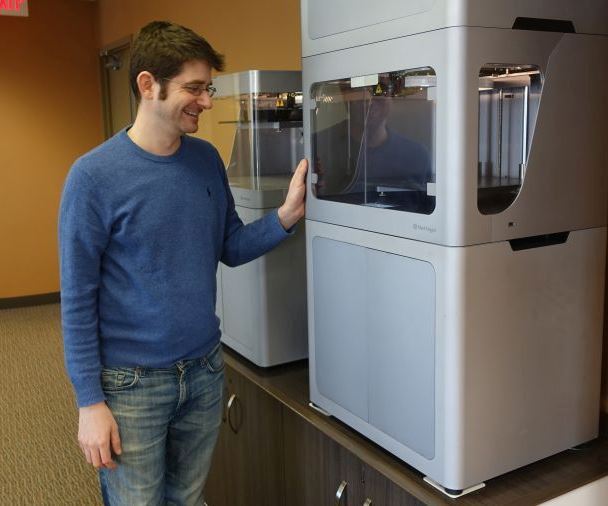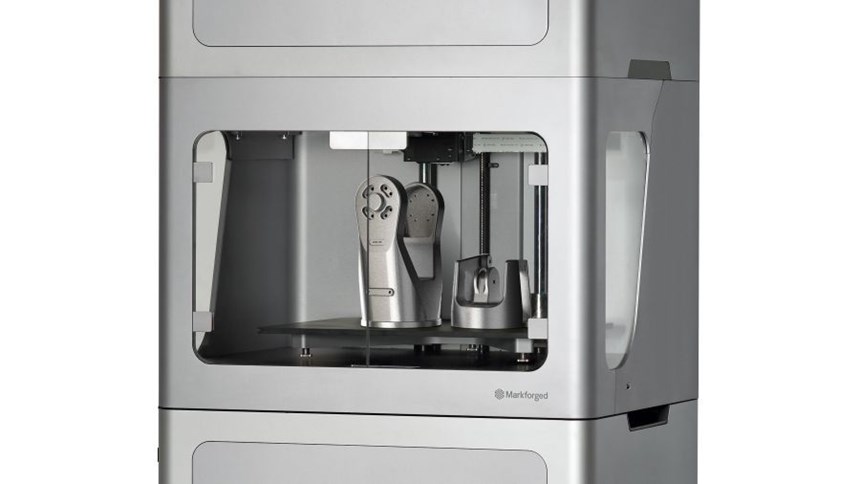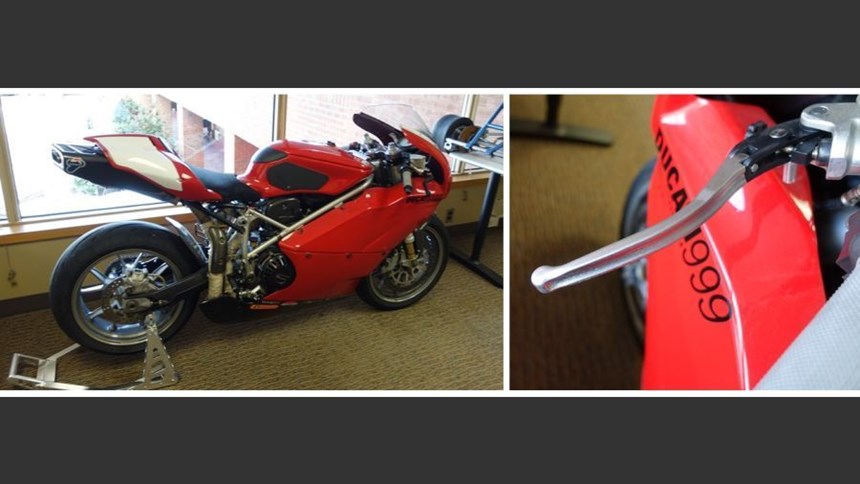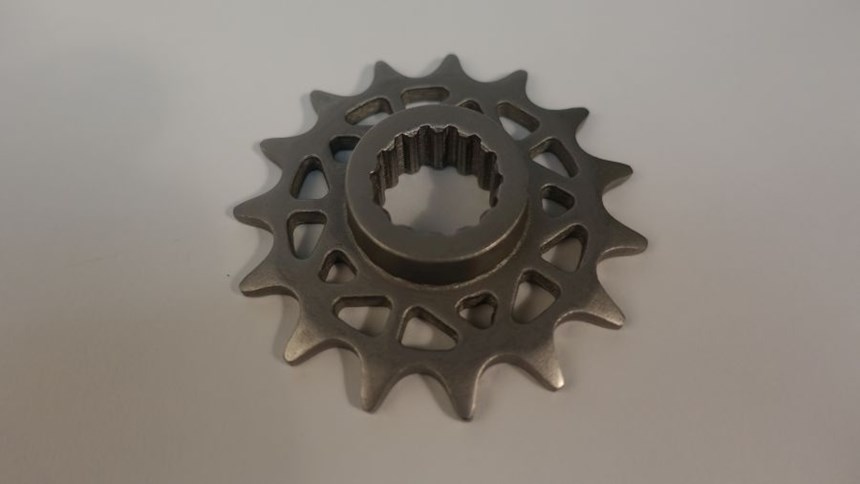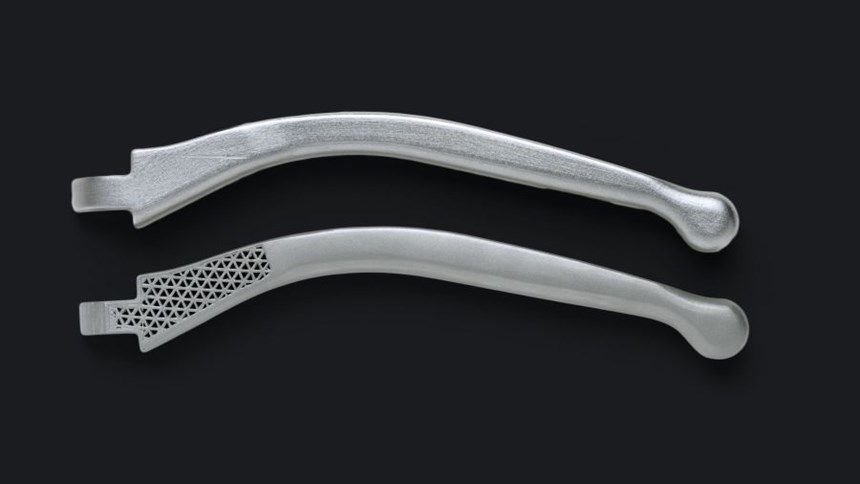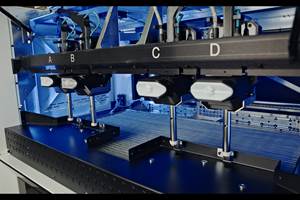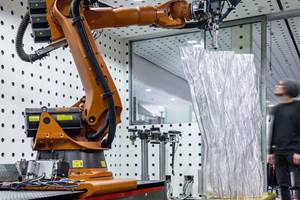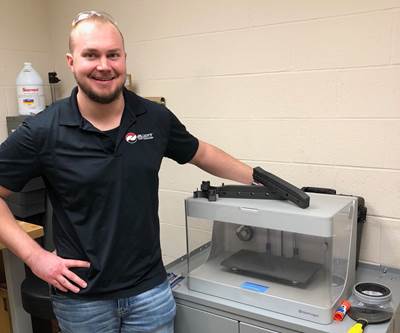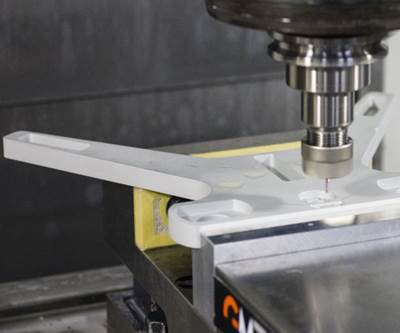FFF 3D Printing for Metal: Sintering Can Wait
Separating 3D printing from high-temperature processing is part of how the Markforged Metal X realizes a price less than established metal AM equipment.
Share
For the sake of argument, let’s say that 3D printing will never produce an end-use metal part that is finished and ready to use immediately after 3D printing, with no other steps required. Forget the Star Trek replicator analogy. For certain tools and components made of plastic, 3D printing alone might be able to produce a part this way. But when it comes to metal, 3D printing simply will not produce a finished part all by itself.
And for the sake of this argument, let’s also recognize that it doesn’t have to.
It doesn’t have to! No metalworking process works this way. Casting, for example, certainly does not produce a completed part. At the very least, the cast part requires flash removal, and in almost all cases, the casting still has to be machined. Indeed, CNC machining is perhaps the process that might come closest to producing a finished part all by itself, but even in this case, the part that is machined almost entirely to completion within an intricate machining cycle still has to be removed from the setup so that the remaining faces of the part can be machined.
It is therefore no inherent shortfall of metal additive manufacturing if the part requires secondary operations after 3D printing to complete it, because when it comes to metal in particular, that is the way manufacturing goes. After 3D printing, depending on the particular method, the operations might include separation from the build plate, removal of support structures, machining and finishing. All of this is necessarily part of additive manufacturing, and the only germane question is whether this sequence of steps—3D printing plus what follows—provides a capable and cost-effective method for making the part. In a growing number of applications, the answer being recognized is yes.
All of this thinking is important, because letting go of the expectation that frames 3D printing as a potential done-in-one process opens up possibilities for what we might consider a viable 3D printing process for metal part production. If we accept that additional steps might always be necessary, then maybe a single 3D printing machine does not have to accomplish so much of the work of creating the part. What if a portion of the part-making, even a crucial portion, could be decoupled and moved to a separate device?
That question is the key to understanding the new metal 3D printer from Markforged, says company founder and CEO Greg Mark, because this machine—the Metal X, which begins shipping in September—decouples printing the part from sintering the metal. I recently visited the company’s office and manufacturing facility in Cambridge, Massachusetts, to speak with Mark about this machine. With the Metal X, the user employs a separate, stand-alone furnace for the sintering. This change, which is a departure from metal 3D printing methods such as DMLS, might leave the AM process seeming less elegant—but hold off on that conclusion. The result of the separation of sintering is a step-change reduction in the cost of the machine. Rather than a high-six-figure price tag, the price of this metal additive machine is $100,000, or around $120,000 when the cost of the furnace is included. The machine at present still has significant limitations, most notably related to the limited range of metals it can predictably use. Still, this is a metal 3D printer at a pricing level that a facility such as a small machine shop can likely afford.
And that step-change cost reduction does not come with a net increase in the number of steps. True, sintering becomes separate with this machine, and that step is not separate with other additive metal equipment. However, another feature of this machine, and the development that actually makes the machine possible, is the use of plastic containment—plastic that ultimately vaporizes—as a delivery mechanism for controlling the pre-sintered powder. Thanks to this plastic containment, there is no powder-handling safety concern. Environmental suits are not part of the protocol for this machine. Also thanks to the plastic, there is no build plate. Neither sawing nor EDM are needed for separating parts from a plate just after they leave the machine. Plus, there is no annealing requirement. As the steps related to safety, heat treat and separation are eliminated, the net number of steps in this metal additive process is actually likely to be smaller.
Part Behavior
Markforged is the company that launched in 2013 to produce and market the Mark One, a desktop 3D printer generating resilient polymer parts that are given their strength through controlled placement of continuous-strand Kevlar or carbon fiber into the build. Variations on the Mark One machine followed, both higher-end and lower-end versions. The metal 3D printer was announced this year, and though the material on this machine is very different (metal rather than polymer composite), this new model is more of a line extension than might initially be recognized. It is an extrusion-deposition machine like the earlier printers (more on the specific mechanism of part creation below), and it uses many of the same components as its predecessors. And within the company, this machine draws on much of the same knowledge the company has already developed related to the behavior of 3D printed parts and how to produce them repeatably.
This last point refers to the dynamic nature of a 3D printing process. Parts are in motion as they are grown; they distort as they are printed. The extent to which the Metal X machines are able to achieve precision sufficient for industrial part production, the aim for all its machines, is partly the result of recognizing this distortion and compensating for it in the machines’ software. That is, the part as literally printed is different from the part in the user’s CAD model, because the software’s algorithms anticipate the ways a form’s dimensions will minutely change by the time the build cycle is done.
Pointing to a plastic part with continuous fiber in it as an example, Mark says, “Look at that straight strand—we didn't just lay it in that way.” Instead, the software executed more intricate machine motions than this to produce pre-distortion geometry so that the final part, after moving through its dynamics, would end up as the part expected. Developing these algorithms has entailed (and still entails) significant trial-and-error investment by the Markforged team in observing part behavior. And this kind of development has also been crucial for software governing the Metal X process, because this process entails not just 3D printing, but also a sintering process. For this latter step, the part printed has to be significantly oversized, since the shrinkage from sintering is consistently 20 percent.
Powder-Laden Plastic
Again, the key detail about the Metal X machine is the form of the material stock. Metal powder is contained within polymer rods that can be handled as safely as the polymer feedstock for any 3D printer. Markforged will be the supplier of this stock. The printer extrudes this metal-laden polymer to 3D print the part through a process that is recognizably fused filament fabrication (FFF), except with the filament replaced by rods. The plastic, which is ultimately sacrificial, is the carrier that enables metal powder to be printed into a precise 3D form at plastic melting temperature (about 250°C) rather than metal alloy melting temperature (more like 1,300°C). Indeed, thanks to this mechanism, the machine extrudes stainless steel using a nozzle that is made of precisely the same stainless steel.
This mechanism is what makes the machine less expensive, Mark says. “Consider what a typical powder-bed metal 3D printer is trying to do, how much it is trying to accomplish,” he says. “To melt and solidify the metal at the same time as building with the metal, you have to achieve high temperatures, you have to control the gaseous environment, and you have to do it all within a machine that needs mechanical motion.” His company’s new machine simply does not have to do all that, since 3D printing and controlled high-temperature sintering are separated. (And to be clear, this separation on its own is not unique. Binder jetting, for example, also separates the printing from the heat.)
Importantly, though, the furnace—which Markforged does not make, instead recommending an appropriate one based on application—is where a crucial part of the process occurs. Just after 3D printing by the Metal X machine, the resulting presintered part is still practically useless. The overall process still has to continue. Markforged has coined the term ADAM for this process: Atomic Diffusion Additive Manufacturing. In the furnace, the plastic vaporizes, with vaporization proceeding as the oversize part is still porous enough to permit the plastic to escape from the metal. Then, as the transformation within the furnace continues, the entirely metal form that remains contracts to its final shape and dimensions. After this, in properties, form and density, the part is the equivalent of a casting, says Mark. Casting without a foundry is a way to think about this process.
In fact, the part can suggest a casting even in appearance, he adds. The softness of the part in its presintered state can be turned to the user’s advantage. Layer lines that are indicative of 3D printing can be smoothed out quickly while the part is soft, using just sandpaper.
But it is the sintering that completes the part, and in a sense, it is during the sintering that the magic happens. And Markforged is still figuring out this magic. For example, what temperature is needed? What atmospheric composition is required? There is also the question of what polymer should carry the metal powder, since the vaporizing of this polymer will affect the atmospheric composition, and therefore potentially affect the metal alloy. For every different metal, the answers to all of these questions are different—and some metals are far more sensitive than others to control over the different variables. (Also, this detail has recently come to light: Parts prepped in a parts washer are easier to sinter. Markforged will sell a parts washer as part of its kit.)
Therefore, company experimenters and customer beta testers are still working to find the sintering formulas to ensure reliable, predictable formation of one metal alloy after another. So far, the number of metal alloys they have nailed down in this way is two: 17-4 and 303 stainless steel. Today, right now, if a user wants a proven process for 3D printing on the Metal X, then the metal would need to be 17-4 or 303.
This is a temporary situation. The work is ongoing, and other metal alloys will be mastered in this way as the months pass. Other materials on the short list for establishing consistent sintering parameters are A-2 and D-2 tool steel, 6061 and 7075 aluminum, and Inconel 625 and titanium 6Al-4V. Out of this list, Mark expects Ti 6-4 to be the last material mastered, because this is a highly reactive and sensitive material that will almost certainly call for tighter control over the sintering variables than what is needed for any of these other metals.
Production Volume
As mentioned, there are beta testers involved in this research. One well-known major manufacturing company (I know what you’re thinking, but it’s not GE) has committed staff and resources toward exploring the Metal X machine as a potential means of part production, seeing promise in this system because of its inherent scalability. That scalability is another advantage of decoupling printing and sintering, Mark notes. The printer might be small, but because it is inexpensive, several of them could be purchased for full production. Then, the furnace could be chosen to accommodate a scale much different from that of any individual printer, sintering large batches of parts at once. This separation of scales is not possible when building the part and melting the part are all inherent within a single box.
Still, the most promising application Mark foresees for the machine is different from metal part production, and in fact relates to production of plastic parts. Understanding this application involves another moment of letting go, similar to the surrender inherent in accepting that additive manufacturing might always involve various steps. The promising long-term application he foresees is making mold tooling for plastics.
He says, “Let’s accept that we will never get a polymer 3D printing process that can compete with injection molding.” In other words, let’s accept that injection molding will always be there because even very fast 3D printing will still be too slow to challenge it. “At high volumes, we will always want to do molding, we’ll always need mold tooling.” And of course, metal 3D printing is already being used to make mold inserts today. His machine potentially offers a low entry price for this work, but that is perhaps not even the most significant point.
There is also the soft state, he notes. There is the possibility for finishing in this state. “Think about how much care, effort and skilled labor are applied to benching mold tooling,” he says. For an intricate or important tool, this benching for a given mold tool could easily be the work of hours.
But now compare that with the possibility of simply sanding the mold tool’s surface while the metal is still soft. Current Metal X beta users have grown accustomed to finishing parts this way. With presintered mold tooling, Mark says, benching a mold insert becomes a step requiring just 10 or 15 minutes.
Related Content
For Coast Guard, AM Adoption Begins With “MacGyver-ish” Crew Members Who Are Using 3D Printing Already
AM suits the Coast Guard’s culture of shipboard problem-solving, says Surface Fleet AM lead. Here is how 3D printers on ships promise to deliver not just substantial cost savings but also an aid to crew capabilities and morale.
Read MoreStratasys F3300 FDM 3D Printer Boosts Productivity, Print Reliability, Part Yield
The F3300 FDM 3D printer is built for performance-oriented manufacturers, expanding the range of production capabilities with improved accuracy, uptime and twice the output.
Read MoreVideo: 3D Printed Hand Tools in Action on Pella Corporation Factory Tour
Examples include an invention for quickly installing window and door weather stripping, a fitting for giving the proper angle to a nail gun, and a clip for which the color is an important feature.
Read More3D Printing Brings Sustainability, Accessibility to Glass Manufacturing
Australian startup Maple Glass Printing has developed a process for extruding glass into artwork, lab implements and architectural elements. Along the way, the company has also found more efficient ways of recycling this material.
Read MoreRead Next
3D Printing Solves Workholding Bottleneck
A 3D printer from Markforged helped Elliott Tool Technology quickly and cost-effectively create fixturing and, eventually, end-use parts for customers.
Read MoreOne-Offs Without Tradeoffs
Does it have to be expensive to produce a one-off part? Does the one-off have to fall short of the manufactured part’s properties? A Boston-area 3D printer maker has an idea for how to produce components that are both low quantity and industrial quality.
Read MorePostprocessing Steps and Costs for Metal 3D Printing
When your metal part is done 3D printing, you just pull it out of the machine and start using it, right? Not exactly.
Read More
